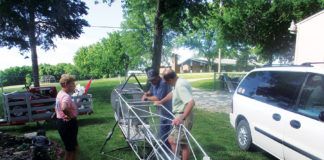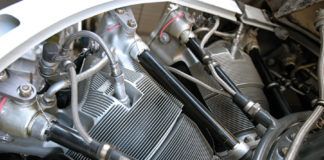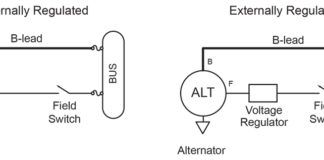Previously, we’ve discussed selection of the proper type of fabric, attaching the fabric to the surface and heat-tautening the fabric. This month the chemical coats are applied to the fabric, and well discuss securing it to the top surface of a wing.
First Chemical Coat
After you have attached the fabric to the airplane surfaces and tightened it properly, you are ready to apply the first coat of chemical. In the Poly-Fiber process, this chemical is called Poly-Brush. Application of this initial coat is generally referred to as sealing the fabric. The first coat of Poly-Brush must bond to the fabric or all subsequent coats are in jeopardy of peeling. Some of you may have witnessed this firsthand. It is a common problem and is a major reason that aircraft must be prematurely re-covered. If the first coat does not bond, you can literally peel off all subsequent coats. I have seen aircraft where you could take an air gun and blow the coatings off of the fabric in sheets. The problem is usually caused by one of three things: 1) The fabric was contaminated with dirt or oil; 2) the chemical was not applied properly; or 3) the chemical was applied in temperatures that were too cold.
The first coat of Poly-Brush also provides a secondary function: It acts as cement that soaks through the fabric and secures the fabric to the airframe. This is particularly important on a plywood surface such as a wing.
I recommend brushing the first coat of Poly-Brush onto the prepared fabric rather than spraying it. This should be done only after you have thoroughly cleaned the fabric using a clean cotton rag and reducer or MEK. All traces of oil and dirt must be removed. A tack rag should then be used to wipe down the fabric just prior to applying the first coat. Failure to remove dirt and oil will result in an inadequate bond.
With the first coat we are working to literally encapsulate the fibers of the fabric. This means the chemical should flow under the fibers and grip them for a good bond. Polyester does not readily absorb liquid, so care must be taken to ensure proper penetration of the chemical through the fabric. This is why I recommend brushing on the first coat. You must penetrate the fabric with the liquid to get it to the back or the underside of the surface. Unless you have experience covering aircraft, it is difficult to tell when you have an adequate penetration if you are spraying this first coat. Though it certainly may be sprayed, do so only if you are an experienced fabric person.
Use a high quality polyester or natural-bristle brush for the first coat. Poly-Brush must be thinned prior to application. It should be three parts of Poly-Brush to one part reducer. Two reducers are available, and you will select one based upon the temperature when you apply the coat. If the temperature is less than 85, you will use the 65-75 reducer. If the temperature is higher than 85, use the 8500 reducer. Do not attempt to brush or spray any coats of Poly-Brush if the temperature is less than 60 F.
Poly-Brush has a pinkish tint, so you can see where it has been applied. If you are covering an open-cockpit airplane where the inside of the fabric will be visible, a clear Poly-Brush is available for use on those areas. Find an old reducer can or some sort of gallon can, and cut the side off to make a trough. This makes a nice container to pour your chemical into before applying it to the fabric. You can place a piece of welding rod through holes in the can to wipe your brush on or to hold the brush out of the liquid.
Brush on a wet coat. Be sure the chemical is penetrating the fabric and flowing to the underneath side. The fabric should appear glossy and wet, with no dry areas. You must be careful not to allow it to drip through to the other side of the surface, as the drips may show up on the final color coats as a difference in gloss. You also need to be careful to work quickly and not leave any brush marks. In normal temperatures the coating will dry rapidly. You will probably see runs on the inside of the fabric. This is perfectly normal, and they will not show on the final product. Just don’t let them drip through to the other side of the piece you’re working on. If you do get drips on the other side, immediately turn the surface over and wipe them off with a clean rag and reducer. This is not necessary if the drip occurs on a surface that has a coat of Poly-Brush already applied. In other words, after completing the first side of the surface, this warning is not important.
The basic idea of this step is to thoroughly brush on a wet coat and then make only one more pass with your brush to level out any small bubbles or marks that may have formed. Work steadily so that you are not still brushing when the surface dries. It will dry fairly rapidly in temperatures above 85-about 5 minutes or so. In cooler temperatures drying takes about 15 minutes. Brushing when the surface is just about dry will leave serious brush marks. Do take some time with this initial step. Unless you thoroughly encapsulate the fabric with the chemical, you will be faced with a major problem within a few years.
What is the solution if you have all of the coatings peeling off of your airplane? Usually the fabric is good. If so, and you can easily peel the coatings to the bare fabric, you can often solve the problem. If the fabric has not been exposed to the sun or lost its strength in any other way, you can reapply the first coat of the process and continue the build-up of the coatings. Seek the advice of someone with fabric experience prior to doing this. If you cannot easily remove all coatings to reach bare fabric, do not try to use a paint stripper. The stripper itself is difficult to remove from the fabric. The best solution is to apply Poly-Brush properly in the first place.
Attaching Fabric to Wingribs
When fabric is used to cover a wing, certain precautions must be taken to ensure the fabric does not balloon-up in flight. Lift on a wing will cause the fabric to attempt to rise up on the top surface and separate from the ribs, and it could be disastrous. You certainly do not want the fabric to separate from the ribs and spoil the lift. If this occurs in flight, an accident is almost certain to follow. What normally occurs in this situation is that the fabric will separate on one rib followed by adjacent ribs as the pressure builds. This acts as a spoiler on one wing with the other wing creating full lift. An uncontrolled spiral results.
You can think of the lift created by normal flight as a giant vacuum cleaner that is trying to peel your wing fabric off the top surface. Beginning with the first aircraft flown in the early 1900s, fabric has been mechanically secured to the ribs. The Wright brothers used a sewn pocket in the fabric itself, into which they inserted the wingribs. (This method is still being used successfully by several ultralight manufacturers.) Bleriot aircraft used a piece of wood physically attached on top of the fabric to the rib below.
So our next step in the covering process is to mechanically attach the fabric to the wingribs. This will also be accomplished on the control surfaces of most aircraft, or any surfaces that create lift. Seldom will you find a fuselage that needs any rib-lacing.
A rib-lacing cord is the most common method of securing the fabric to the ribs of a surface. This cord is made out of polyester material and is extremely strong. A special needle is used to tie a specific knot in this process. Other methods of attaching fabric to ribs include the use of screws, pop-rivets and special fabric clips.
Mechanical Attachments
With the advent of the ultralight, a number of people have used alternative methods of fabric attachment including cementing the fabric to the ribs. This has become somewhat common recently, using cements designed for fabric, and the ribs are made a bit wider to accommodate it. At Poly-Fiber, fabric cements have been designed to hold two pieces of fabric together against the shear forces that may try to pull them apart. The fabric on the leading edge of a wing is overlapped by 2 inches, and that overlap is secured by applying fabric cement to the two pieces of fabric, thereby holding them in place. However, the fabric cement is not designed for peel forces that result from the lift created during flight. I recommend using a form of mechanical attachment when securing the fabric to the ribs. Gluing without a mechanical attachment is simply asking for potential problems. Why take the chance when the fabric may be secured properly with a little extra effort?
On production aircraft, the method used to secure the wing fabric to the wingribs should be the same one used at the factory when the airplane was manufactured. If you want to use an alternative method you must obtain FAA approval. On Experimental aircraft, you may use whatever means you desire. I would suggest rib-lacing. If your plans call for cementing the fabric to the ribs, you should also rib-lace as an added precaution. If you are concerned about tying the proper type of knot, you might attend one of the EAA/SportAir fabric workshops or visit one of the workshops held at various airshows. The knot is demonstrated and practiced at these events. The knot may appear to be challenging when in fact it is quite simple. If you have an Experimental aircraft and you are having problems with the rib-lacing knot, simply tie square knots with each lace spaced properly. The proper spacing requirements may be found in the Poly-Fiber Covering Manual or in FAA Advisory Circular 43-13. The distance between the mechanical attachments depends on the never-exceed speed of the aircraft. As an example, if the Vne of your airplane is 150 mph, the distance between fabric attachment points on each rib will be 2.5 inches within the slipstream of the propeller and 3.5 inches outside the slipstream.
Remember to attach the fabric mechanically, using the method recommended by the manufacturer. If you insist on cementing the fabric to the ribs, add an additional safety margin by rib-lacing. If you are covering an ultralight or a slow, low-horsepower aircraft, simply tie a square knot every 3 to 4 inches to secure the fabric properly. It takes only a few hours and a few dollars to ensure that you will never have problems. By the way, use only approved rib-lacing cord. I have seen everything from string to fishing line used. Don’t do that! You will be placing yourself in unnecessary jeopardy.
Next month we will continue with a complete discussion on proper techniques of rib-lacing and other methods of fabric attachment.




